Comets and Meteors: Difference between revisions
mNo edit summary |
mNo edit summary |
||
| (4 intermediate revisions by 2 users not shown) | |||
| Line 1: | Line 1: | ||
{{draft}} | {{draft}} | ||
<!-- [[Category:Science]][[Category:Secondary]] --> | |||
{{Rinfo | |||
|type= Lesson idea | |||
|attribution={{Chris Tooley}} | |||
{{ | |||
|title= Comets and Meteors | |title= Comets and Meteors | ||
|subject= | |subject=Science | ||
|topic= | |topic=Astronomy | ||
|resourcenumber= SC0031 | |resourcenumber= SC0031 | ||
|age= | |age= Secondary | ||
|content= | |content=Other presentations in this series have focused on the Earth's structure and others will consider its place in the solar system. Comets and meteors conveniently link them by considering the formation of planetary objects. Many people believe that a comet's tail is caused by friction as the comet moves through space. But this cannot be as the comet moves through a vacuum. In fact, the tail of the comet only appears when it is near the sun. The solar wind transfers energy to the comet and causes particles to be carried away in a stream of energy... The presentation is accompanied by a commentary from the teacher. | ||
|image=comet1.png | |||
|tagline=When a comet approaches the sun its tail is behind it. When it is moving away from the sun the tail is in front. Go figure. Or read more. | |||
|format= | |format= | ||
|Learning Objectives = | |Learning Objectives = | ||
* explain the nature of comets and meteors | |||
* discuss evidence for meteor strikes and their effect on the Earth | |||
* discuss the implications of comets and meteors affecting politicians | |||
|strategy= | |strategy= | ||
|additional resources= | |additional resources= | ||
| Line 17: | Line 24: | ||
|other= | |other= | ||
|resources= [[media:Comets and Meteors voiceover.mp3]] | |resources= | ||
* Teacher's audio explanation of how the lesson was delivered [[media:Comets and Meteors voiceover.mp3]] | |||
The presentation has been converted to alternative formats: | |||
* Smartboard notebook version [[File:]] | |||
* Powerpoint version:[[File: ]] | |||
* PDF version [File: ]] | |||
}} | }} | ||
Latest revision as of 21:07, 2 October 2012
Lesson idea. Other presentations in this series have focused on the Earth's structure and others will consider its place in the solar system. Comets and meteors conveniently link them by considering the formation of planetary objects. Many people believe that a comet's tail is caused by friction as the comet moves through space. But this cannot be as the comet moves through a vacuum. In fact, the tail of the comet only appears when it is near the sun. The solar wind transfers energy to the comet and causes particles to be carried away in a stream of energy... The presentation is accompanied by a commentary from the teacher.
Teaching approach. The lesson model is that of active note-making. Students must not take notes from the board but instead must use their creativity to develop their own notes. They are encouraged to use colour, image, symbols, humour and metaphor to lead them through a richer learning experience. Students need help in achieving this but soon catch onto the idea. They become more independent with taking notes and more attentive to the subject at hand. (edit)
| Resource details | |
| Title | Comets and Meteors |
| Topic | [[Topics/Astronomy|Astronomy]] |
| Teaching approach | [[Teaching Approaches/|]] |
| Learning Objectives |
|
| Subject | [[Resources/Science|Science]] |
| Age of students / grade | [[Resources/Secondary|Secondary]]
|
| Files and resources to view and download |
The presentation has been converted to alternative formats:
|

